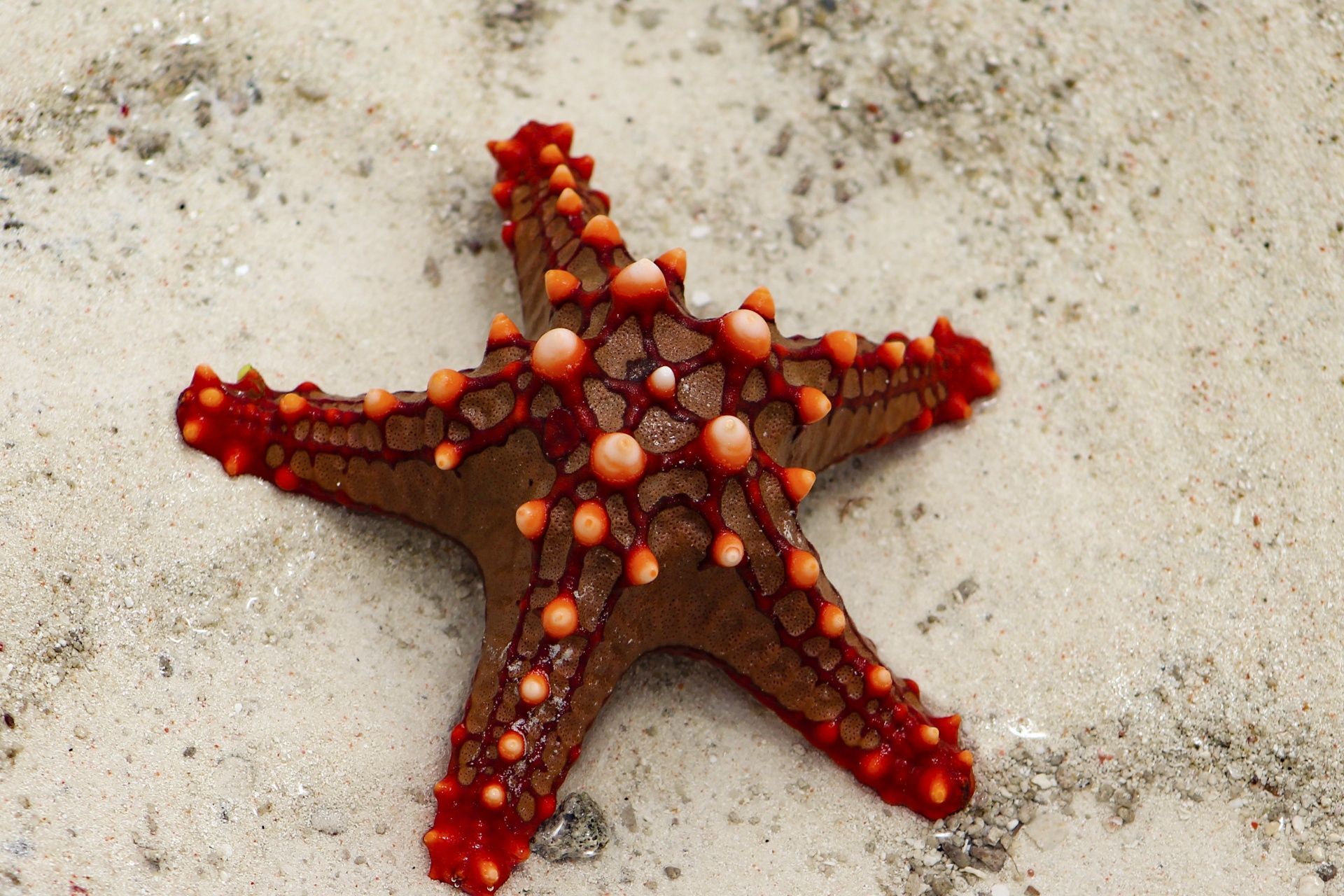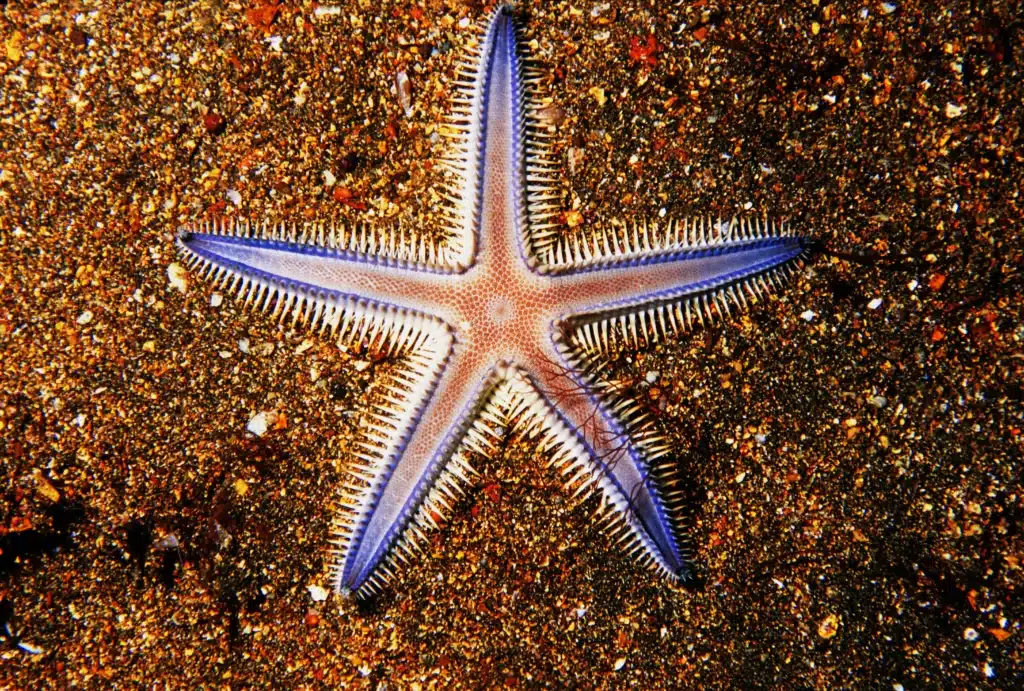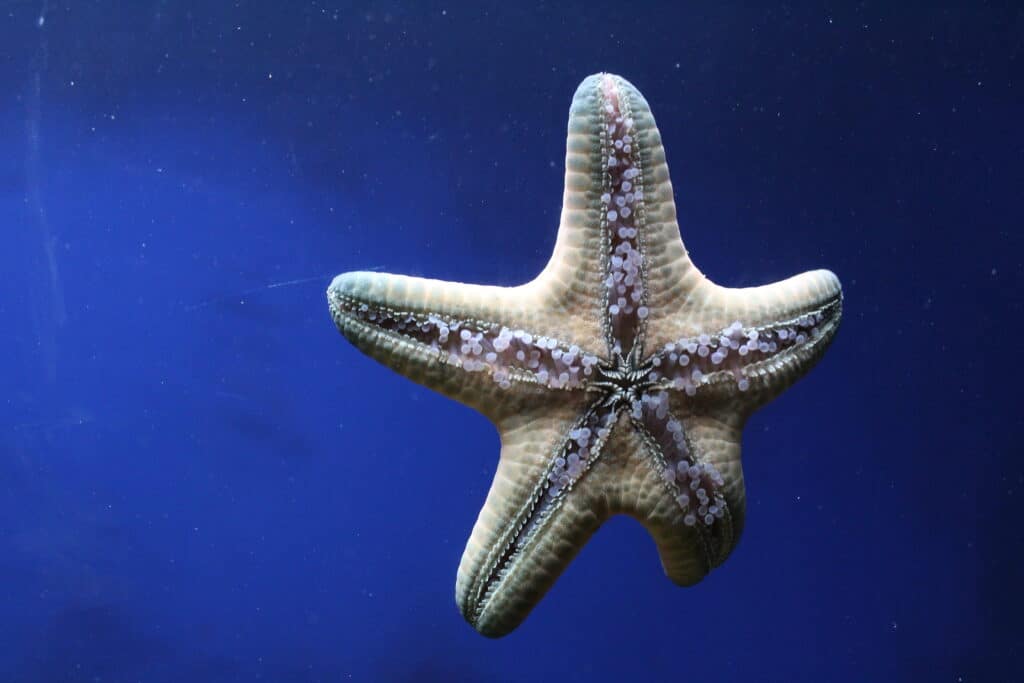Are Starfish Carnivores

Introduction
Are Starfish Carnivores: Starfish, also known as sea stars, are fascinating marine creatures that have captured the curiosity of scientists and nature enthusiasts alike. These iconic echinoderms are often associated with their distinctive five-pointed radial symmetry and striking colors, which make them a common sight in coastal waters around the world. While starfish may appear benign and gentle as they slowly move along the ocean floor, they are indeed carnivores with a surprising predatory nature.
The popular perception of starfish as gentle herbivores is somewhat misleading. Although some species are omnivorous or scavengers, many starfish are primarily carnivorous predators. They exhibit a diverse range of feeding strategies, and their diet typically consists of a variety of marine organisms, including mollusks, crustaceans, and other small invertebrates. Some larger species are even known to feed on bivalve mollusks, which they pry open with their remarkable tube feet and powerful arms.
In this exploration of starfish as carnivores, we will delve into the intriguing world of these enigmatic creatures. We will examine their feeding habits, mechanisms of predation, and the remarkable adaptations that enable them to thrive in their aquatic environments. By shedding light on the predatory side of starfish, we can gain a deeper appreciation for the complexity and diversity of life beneath the waves.

Is a starfish a herbivore or omnivore?
Starfish are mostly carnivores and scavengers. Other species are omnivores. These organisms feed on slow-moving creatures like bivalves, gastropods, polychaetes, and barnacles. Other starfish feed on planktons, organic detritus, and fish.
The dietary habits of starfish, also known as sea stars, are a subject of intrigue within the field of marine biology. The classification of starfish as herbivores or omnivores can be somewhat complex, as it varies among different species.
Many people perceive starfish as herbivores due to their seemingly gentle appearance. While some species primarily feed on algae and plant material, they are not strictly herbivorous. These starfish use their tube feet to glide across surfaces and graze on algae and detritus found on rocks and substrates.
However, it’s essential to recognize that not all starfish fit the herbivore label. Numerous starfish species are opportunistic feeders and exhibit omnivorous tendencies. They feed on a diverse range of prey, including mollusks, crustaceans, small invertebrates, and even carrion. Some larger species are known for their remarkable ability to pry open bivalve mollusks with their strong arms and tube feet, showcasing their carnivorous nature.
In essence, the dietary preferences of starfish are highly adaptable and dependent on their specific ecological niche and the availability of food resources in their habitat. Therefore, rather than definitively classifying starfish as herbivores or omnivores, it’s more accurate to acknowledge the wide spectrum of feeding strategies exhibited by these fascinating marine creatures.
Is a starfish a producer herbivore or carnivore?
Starfish are consumers. They do not produce their own food so they must eat other living organisms such as snails, fish, and barnacles. Starfish also eat algae and aquatic plants. Since starfish aren’t fish, by the way, the animal has been renamed sea star.
Starfish, also known as sea stars, are fascinating marine animals that exhibit a variety of feeding strategies depending on their species and ecological niche. To classify them as producers, herbivores, or carnivores, we need to consider their role in the marine ecosystem.
Producers: Starfish are not producers. Producers are organisms, such as plants and algae, that can synthesize their own food through photosynthesis. Starfish lack the chloroplasts necessary for photosynthesis and cannot produce their own food from sunlight.
Herbivores: While some people might associate starfish with herbivory due to their seemingly slow and gentle movement along the ocean floor, not all starfish are herbivores. Some species feed on algae and detritus, earning them the label of herbivores. These starfish use their tube feet to graze on plant material and other organic matter adhering to rocks and substrates.
Carnivores: Many starfish species are carnivorous predators. They primarily prey on other marine animals, including mollusks, crustaceans, and small invertebrates. Some large starfish species are well-known for their ability to pry open bivalve mollusks with their tube feet and strong arms.
Starfish encompass a wide range of feeding habits, from herbivorous to carnivorous tendencies. Their classification as producers, herbivores, or carnivores depends on their specific species and diet, making them versatile and adaptable members of the marine ecosystem.
Is a starfish a carnivore or omnivore?
Nearly 2,000 species exist. Although the five-arm species is the most common, some sea stars have as many as 40 arms. Most are carnivores, using specialized organs to feed on mussels, clams and other slow-moving organisms.
Starfish, also known as sea stars, are predominantly carnivorous creatures, although their dietary habits can vary among different species. While some people might classify them as omnivores due to their occasional consumption of plant material and detritus, it’s essential to recognize that the majority of starfish species are primarily carnivores.
Carnivores: Many starfish exhibit clear carnivorous tendencies. They actively hunt and prey on various marine organisms, including mollusks, crustaceans, small invertebrates, and even carrion. Some larger species are renowned for their ability to pry open and feed on bivalve mollusks using their powerful tube feet and strong arms. These behaviors underscore their carnivorous nature.
Omnivores: While there are instances where starfish might consume algae, plant material, or organic debris found on rocks or substrates, this behavior is not universal among all species. It’s more accurate to consider these instances as opportunistic feeding rather than a regular part of their diet.
Starfish are primarily carnivores, with most species actively preying on other marine animals. While they may occasionally consume non-animal matter, this behavior is not a defining characteristic for the majority of starfish and does not warrant classifying them as omnivores.
Why are starfish carnivores?
Sea Stars Are Carnivores
Because starfish are very slow movers, they eat animals that also move slowly. They usually feed on coral, sponges, clams, oysters, sand dollars, and mussels because these animals also attach themselves to rocks and move slowly, so they’re nearby.
Starfish, or sea stars, have evolved to be carnivores as a result of their ecological niche and the challenges they face in their underwater environments. Several factors contribute to their carnivorous nature:
Habitat and Adaptations: Starfish inhabit a variety of marine ecosystems, from intertidal zones to deep ocean floors. Their adaptations are suited for these habitats, where they encounter an array of potential prey.
Predatory Advantage: Being carnivores provides starfish with a distinct advantage in their quest for food. Predatory behavior allows them to actively seek out and capture a variety of prey, including mollusks, crustaceans, and small invertebrates.
Nutritional Requirements: Carnivory is essential for meeting starfish’s nutritional needs. Animal prey typically contains higher energy and nutrient content than plant material, allowing starfish to thrive in often nutrient-poor marine environments. This diet helps sustain their growth, reproduction, and overall survival.
Ecological Role: Starfish play a crucial role in marine ecosystems by regulating the populations of various prey species. Their predation helps maintain ecological balance, preventing overpopulation of certain organisms that could disrupt the ecosystem.
Starfish have evolved to be carnivores as a result of their habitat, adaptations, and nutritional requirements. Their predatory behavior is integral to their survival and contributes to the intricate web of life in marine ecosystems.
Is a starfish a secondary carnivore?
Regardless of how far out from the ocean they are, a starfish is considered to be an omnivore. This means that they sustain themselves off of both plant material and other animals. It’s hard to think of a starfish as being carnivorous, but they do consume underwater sea creatures such as mollusks, mussels, and clams.
Starfish, also known as sea stars, are generally considered primary carnivores rather than secondary carnivores in marine food webs. Understanding their trophic role can help clarify this classification:
Primary Carnivores: Primary carnivores are organisms that directly consume other animals for their primary source of nutrition. Starfish are classified as primary carnivores because they primarily feed on a variety of marine prey, such as mollusks, crustaceans, and small invertebrates. They actively hunt, capture, and consume these organisms as their primary food source.
Secondary Carnivores: Secondary carnivores, on the other hand, are organisms that feed on primary carnivores or other consumers. These secondary consumers obtain energy by preying on herbivores or primary carnivores. They occupy a higher trophic level in the food chain compared to primary carnivores.
While starfish are undoubtedly carnivorous predators, they typically occupy a lower trophic level as primary consumers in marine food webs. They are known for regulating the populations of various prey species and playing a role in maintaining the balance of marine ecosystems. Secondary carnivores in the marine environment might include animals like larger fish that feed on smaller fish or other carnivores.
How do starfish catch their prey?
Starfish employ a combination of remarkable adaptations and feeding strategies to catch their prey. While the specific techniques can vary among different species, the general process involves the following steps:
Sensory Detection: Starfish have specialized structures on their tube feet and arms that can detect chemical signals, allowing them to locate potential prey. These sensors are sensitive to vibrations and chemical cues released by nearby organisms.
Slow Approach: Starfish are not fast-moving creatures. Instead, they use their tube feet to glide slowly and methodically towards their target, minimizing disturbance and avoiding startling their prey.
Encircling and Restraining: Once within reach, starfish extend their tube feet to encircle the prey. They use their tube feet and arms to grasp and immobilize the prey. Some species may also use tiny pincers on their tube feet to grip their prey.
Applying Pressure: Starfish have a unique hydraulic water vascular system that allows them to exert pressure on their tube feet, enabling a secure grip on the prey. This pressure helps them pry open the shells of mollusks or hold onto struggling prey.
Feeding: With their prey captured and immobilized, starfish use their specialized stomachs to evert (turn inside out) and digest the prey externally. They release digestive enzymes onto the prey’s body, which break down tissues. The liquefied prey is then absorbed back into the starfish’s body.
This combination of sensory perception, slow but methodical movement, and hydraulic-powered gripping allows starfish to efficiently catch and consume a variety of prey in their aquatic environments.
Are all starfish carnivores?
Because of this ability to digest food outside the body, starfish can hunt prey much larger than their mouths. Their diets include clams and oysters, arthropods, small fish and gastropod molluscs. Some starfish are not pure carnivores, supplementing their diets with algae or organic detritus.
While many species of starfish are indeed carnivores, not all starfish are exclusively carnivorous. Starfish exhibit a diverse range of feeding strategies, and their dietary habits can vary depending on their species and environmental factors. Here’s an overview of the different dietary preferences observed in starfish:
Carnivores: The majority of starfish species are primarily carnivorous. They actively hunt and feed on various marine animals, including mollusks, crustaceans, small invertebrates, and even carrion.
Herbivores: Some starfish species primarily feed on algae, plant material, and detritus found on rocks and substrates. While this herbivorous behavior is less common among starfish, it does exist in certain species.
Omnivores: Some starfish can be considered omnivores as they consume a combination of both plant material and animal prey. However, this omnivorous behavior tends to be opportunistic rather than a primary dietary strategy.
Scavengers: In addition to actively hunting, starfish are also known to scavenge for food. They may feed on dead or decaying organisms they come across on the ocean floor.
Starfish encompass a wide spectrum of dietary preferences, ranging from carnivorous to herbivorous tendencies, with some species exhibiting omnivorous or scavenging behavior. The specific diet of a starfish depends on its species, habitat, and the availability of food resources in its environment.
Do starfish have any predators?
Starfish, like many other organisms in marine ecosystems, do have predators, although their ability to escape or defend against these predators can vary depending on the species and life stage. Here are some of the key predators of starfish:
Sea Otters: Sea otters are known to prey on certain species of starfish, particularly those with softer bodies. They are especially skilled at hunting sea urchins, which are related to starfish and can be abundant in some habitats.
Birds: Various seabird species, such as gulls and cormorants, are known to feed on starfish when they are exposed during low tide or washed ashore.
Fish: Some fish species, like triggerfish and pufferfish, are known to consume starfish. They are particularly skilled at extracting and consuming the softer parts of the starfish.
Crabs: Some species of crabs are opportunistic predators and will feed on small starfish if they come across them.
Predatory Snails: Certain species of snails, like the Pacific moon snail, have specialized mouthparts for drilling through the shells of bivalve mollusks. They can also prey on starfish.
Humans: While not natural predators, humans can collect and consume certain species of starfish in some regions, although this is less common and typically not a significant threat to starfish populations.
It’s important to note that the susceptibility of starfish to predation can vary widely based on factors like their size, species, and the presence of physical defenses like spines or tough exoskeletons. In some cases, starfish may use their regenerative abilities to regrow lost limbs after escaping a predator, adding to their survival strategies.

Conclusion
The world of starfish is far more intricate and captivating than their serene appearance might suggest. While they may seem like passive, herbivorous creatures, many starfish species are, in fact, carnivorous predators that employ a range of fascinating feeding strategies. These marine marvels have evolved over millions of years to thrive in diverse aquatic ecosystems, demonstrating remarkable adaptations that make them efficient hunters.
The starfish carnivores provides valuable insights into the intricate balance of life in the ocean. Their role as predators influences the composition of marine communities and helps regulate the populations of various prey species. Furthermore, understanding the predatory nature of starfish enhances our appreciation for the intricacies of marine ecology and underscores the importance of preserving these delicate ecosystems.
As we delve deeper into the world beneath the waves, we discover that even the most seemingly tranquil creatures harbor hidden complexities. Starfish, with their unique feeding behaviors and captivating adaptations, serve as a testament to the wonders of the natural world. By continuing to explore and research these enigmatic creatures, we contribute to our understanding of marine life and the delicate web of interactions that sustains it.



